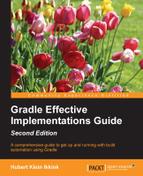In Gradle, projects and tasks are two important concepts. A Gradle build always consists of one or more projects. A project defines some sort of component that we want to build. There are no defining rules about what the component is. It can be a JAR file with utility classes to be used in other projects, or a web application to be deployed to the corporate intranet. A project doesn't have to be about building and packaging code, it can also be about doing things such as copying files on a remote server or deployment of applications to servers.
A project has one or more tasks. A task is a small piece of work that is executed when we run a build, for example, compiling source code, packaging code in an archive file, generating documentation, and so on.
In this chapter, we will discuss how to define a project with tasks and use it as a Gradle build. We will cover the following topics:
- Defining tasks
- Defining dependencies between tasks
- Organizing tasks and ways to handle it
In the first chapter, we have already written our first build script. Let's create a similar build script with a simple task. Gradle will look for a file with the name build.gradle in the current directory. The build.gradle file contains the tasks that make up our project. In this example, we define a simple task that prints out a simple message to the console:
// Assign value to description property.
project.description = 'Simple project'
// DSL to create a new task using
// Groovy << operator.
task simple << {
println 'Running simple task for project ' +
project.description
}
If we run the build, we see the following output in the console:
:simple Running simple task for project Simple project BUILD SUCCESSFUL Total time: 0.57 secs
A couple of interesting things happen with this small build script. Gradle reads the script file and creates a Project object. The build script configures the Project object, and finally, the set of tasks to be executed is determined and executed.
So, it is important to note that Gradle creates a Project object for us. The Project object has several properties and methods and it is available in our build scripts. We can use the project variable name to reference the Project object, but we can also leave out this variable name to reference properties and methods of the Project object. Gradle will automatically try to map properties and methods in the build script to the Project object.
In our simple build script, we assign the Simple project value to the description project property. We used the explicit project variable name and Groovy property assignment syntax. The following build script uses a different syntax, which is a bit more like Java, to get the same result:
// Use setDescription method
// to assign value instead of
// Groovy assignment.
project.setDescription('Simple project')
// Use create method to add new
// task instead of Groovy << operator.
project.getTasks().create('simple') {
println 'Running simple task for project ' +
project.description
}
Here, we use the Java syntax to set and get the value of the description property of the Project object. We are very flexible in our syntax, but we will stick to the Groovy syntax for the rest of the book as it results in more readable build scripts.
